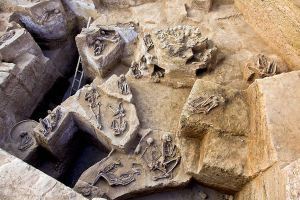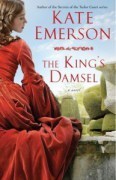Eric Timar's Blog, page 5
September 30, 2012
Forthcoming from Pannonius Books
Vikings On The Beach: Norse Settlements in Southern Italy, 998 – 1106 A.D. — Historian David Straithaird shares meticulous Eleventh Century records from a Viking colony on the Mediterranean which show how the Northerners succumbed to the relaxed atmosphere of the beach and nearly lost their identity; local women, for example, took advantage of the lowered guard of the Vikings to fleece them of their possessions, from their swords all the way up to their longboats. October 15.
 Extreme BeaverScaping — Four rescued beavers submerge four acres of a Minnesota family’s farm with dams after the family takes them out of shelters subsequent to hunting and traffic accidents. Brian and Cindy Love Johnson, with their three children, rescued the beavers over the course of a year before realizing the massive change even one beaver could wreak on a rural area by felling trees and stopping up streams. The family perseveres despite the damage. By Brian and Cindy Love Johnson with Stan Whitfordson. November 1.
Extreme BeaverScaping — Four rescued beavers submerge four acres of a Minnesota family’s farm with dams after the family takes them out of shelters subsequent to hunting and traffic accidents. Brian and Cindy Love Johnson, with their three children, rescued the beavers over the course of a year before realizing the massive change even one beaver could wreak on a rural area by felling trees and stopping up streams. The family perseveres despite the damage. By Brian and Cindy Love Johnson with Stan Whitfordson. November 1.
The Jackman Payout — Twenty-eight-year-old Constance Friedlyn found ninety thousand dollars in cash in an attache case “hidden” beneath a pedestrian bridge in Washington D.C.’s Battery Kemble Park in 2005. Her attempt to do the honest thing and turn the money in to local police morphed into a capital-area farce as several anonymous organizations apparently became extremely nervous about the find and contacted her privately to convince her to claim it herself. This true story, complete with a car chase and nighttime meetings with shadowy contacts, will make anyone who has ever hoped to chance upon buried treasure think twice. Nonfiction by Ed Sanders. November 5.
Recently released — White Cedar Press, new fiction by Eric Timar:
https://www.createspace.com/3936253


August 12, 2012
Review: The Hounds of Nemhain, Kathy Cecala
 This enjoyable young adult novel is set on an island just off the coast of Ireland in 350 A.D. Bran, a teenage boy who leaves his inland village to journey to the coast, is taken by a group of outlaws and has to survive among them — not quite a slave but not quite free, either.
This enjoyable young adult novel is set on an island just off the coast of Ireland in 350 A.D. Bran, a teenage boy who leaves his inland village to journey to the coast, is taken by a group of outlaws and has to survive among them — not quite a slave but not quite free, either.
The historic detail of the novel is convincing and transporting, both in the portrayal of daily life and the relationships of different ethnicities and social classes. Regarding the everyday details, Bran comes from a realistically middling-poor family, is not familiar with glass, and does not know what snakes are, either. (I learned that Ireland is snake-free just a few years ago, thanks to an exhibit at a nature center which I viewed with my children. One of the many things I have learned for which I can thank my kids.)
Regarding the classes of Fourth Century Ireland and Britain: Romans have subjugated southern Britain, of course; but even among the Irish, neighboring groups do not get along and strangers often try to exploit each other. Irish villagers living just a few days’ journey inland are not familiar with coast residents, and vice versa.
Furthermore, due to the “globalization” sparked by the Roman Empire, other foreigners who are not from the British Isles nor Rome either are preyed upon by the raiders.
The plot moves along well; Bran is very aware that he is coming of age, and he asserts himself. The engaging characters include a strong young Irish woman; a well-drawn, pragmatic raider; a displaced young Roman; and others.
My only quibble is the recommended age range for readers; the back cover says 14+, but I think it’s fine for 12 and up.
This book is described as one of a series about the small Irish island; the other volume that has been published to date is far removed in time from this one, and Hounds stands alone.


August 6, 2012
Historical fiction covers: Can you spot the difference?
My novel Pearl Lagoon is historical fiction. See if you can find any subtle differences between its cover and those of some other recently-reviewed historical novels:
Looks like maybe I should have pictured Dorette Fox on the cover – maybe mounted on her horse, pistol in hand, or else on the mayor’s front porch in her glass-button dress – instead of a vintage map.
Ah, well – I love vintage maps.
The other novels are:
Entwined, by Heather Dixon, which received a great review on August 3 on this site:
The Second Empress, by Michelle Moran, which received a great review on August 3 on this site:
http://historicalnovelreview.blogspot.com/
The King’s Damsel by Kate Emerson, which received a great review on July 29 on this site:
http://historical-fiction.com/
The Queen’s Vow by C. W. Gortner, which received a great review on July 24 on the same site:
http://historical-fiction.com/


July 18, 2012
Requesting cease-and-desist letter
NPR thi s morning reported that the Olympics organizers are zealously/jealously policing the use of their trademarks.
s morning reported that the Olympics organizers are zealously/jealously policing the use of their trademarks.
http://www.npr.org/2012/07/18/156918508/for-olympic-committee-marketing-is-no-game
“This year, according to the USOC’s Lisa Baird, the enforcers are on high alert. You can’t use anything related to the Olympics if you haven’t paid for it.
” ‘You may not use any of our marks,’ she says. ‘You may not use our licensed footage. You may not use insinuation even to really convey that you might have a relationship with either the committee or the U.S. Olympic Team.’ “
You’ve all heard of the club of knitters who were sent a cease-and-desist letter because they called an event of theirs the Ravelimpics. Very good, let’s move on.
As a test, I am using the Olympic rings in this post to see if anyone gets in touch to crack down. Now, you might object that no one with the Olympic Committee (or whoever it is) will care, because I am not trying to use the logo to sell anything; well, let me say that my books, for which you can find links above, are of Olympic, gold-medal quality.
(I’m sure I’m not the only blogger to whom this has occurred, by the way.)
Enforcers may get in touch with me via this link:


June 21, 2012
Learning Cursive Through Bribery
My son, going into third grade in the autumn, spent some time learning cursive this past year. Students in our system typically do not practice cursive much, if at all, after this 2nd-grade introduction.
We want him to learn cursive, so we are going to reward him for completing a workbook this summer. He was given the workbook in class but they finished only about a third of it. (They did learn all the letters, but did not do all the practice pages). I have told him I will buy him a $30 Lego set when he is done. He is on board.
(His cursive is actually surprisingly good, and he does not mind doing it. Oh, he announces some token complaints about it, because he hears his older sister doing the same, but he has dutifully sat down to complete the pages every day with minimal prodding [other than the promised Lego].)
Someday he’ll want to handwrite a letter to a woman, and he’ll thank us that he won’t have to do it in printed letters that look like a patch of tomato stakes and candy canes.








May 18, 2012
Congrats — your family won a slot in the sacrifice tonight!
 It’s not too difficult to find stories of archaeological digs which turn up groups of men, women, and children who were apparently ritually sacrificed.
It’s not too difficult to find stories of archaeological digs which turn up groups of men, women, and children who were apparently ritually sacrificed.
I always wonder: Did anyone in those societies object to this? Or did they all just nod along and hand over their family members to have their hearts ripped out?
I have a hunch that professionals would consider me naïve for even asking the question . . . but, well, Spartacus did not play along with his culture’s rules about slavery. He was an example of dissent, two thousand years ago in a complex society with a strong ruling class. Other ancient societies might have had dissent, also.
Here is a wonderful blog post about apparent ritual sacrifices, by a grad student named Katy Meyers:
http://bonesdontlie.wordpress.com/2012/01/03/mass-sacrifice-in-peru/
She writes about an excavation of a thousand-year-old site, in Peru:
“The interpretation of the site is that the pyramid is a funeral monument to an elite royal with a mass sacrifice of humans in his honor.”
Meyers titles her blog Bones Don’t Lie, which reminds me:
We would not be able to learn about any dissenters in these ancient societies as easily as we can learn about those who apparently abided by the rules, because, for one thing, it was the people who abided by the rules whose bones we find in the mass burials. If twenty families handed over their kids to be slaughtered to accompany the dead king into the underworld, archaeologists may dig up those bones and conjecture about what happened; but if one family said “screw that” and ran away into the rainforest to become freethinking outlaws, archaeologists would never be able to tell.
Also, it is the people who made the rules, and abided by the rules, who left behind written evidence. Meyers writes:
“Also, there is clear iconography on the pyramid showing sacrificial processions of young females.”
Now, there may also have been a few families who refused to have their daughters in the processions; but they would not have had the power to leave carvings on monuments. Perhaps after they ran away into the rainforest, they passed down their beliefs orally for a few generations; Dad took his daughter on his knee and told her, “Daughter, we live out here in the middle of nowhere because back in town the prince wanted to kill you and bury you for his dad’s funeral, and I took exception to that;” but he would have left behind no carving about this for archaeologists to discover.
What do you think – too naïve? Did NO parents think that way, back then?
Again going back to ancient Rome, I remember reading once about a graffiti caricature of a Roman which archaeologists believe was drawn by a slave. There we have it, again: dissent. Maybe the odd ancient commoner in Peru, now long-forgotten to history, also dissented.
This Big Question of mine is why I wrote about the ancient Mayan, Zucul, in my story, “Pyramid Spleen.” You don’t need to read it, now that you’ve read this; but anyway, I wonder if there were people like him. Is it human nature to dissent?








April 19, 2012
Children’s book review: The Boy Who Loved Ants, Sara van Dyck
 This is a terrific children’s book about the entomologist Edward O. Wilson. Wilson is an emeritus professor at Harvard who has written books about diverse subjects including human and animal behavior, but The Boy Who Loved Ants focuses on his youth and his early studies. The book is listed as being for ages 7 and up.
This is a terrific children’s book about the entomologist Edward O. Wilson. Wilson is an emeritus professor at Harvard who has written books about diverse subjects including human and animal behavior, but The Boy Who Loved Ants focuses on his youth and his early studies. The book is listed as being for ages 7 and up.
The writing is very smooth; van Dyck is a former teacher, and it shows. (She has published other books with traditional publishers.) The story starts with Wilson at age 6 and most of it concentrates on his pursuits through and just after college. Most of the stories are about, of course, ants. At age 13, for example, Wilson was the first person to record the presence of the invasive fire ant in the United States.
This story of Wilson ends with a description of his efforts to preserve habitat, and an explanation of why small animals and insects are just as important to the environment as larger, better-known fauna. The book itself ends with activities for children to learn about wildlife near their homes; these are good, quick, very do-able activities. (I don’t know about other parents out there, but sometimes I find myself reading “Science Projects Your Child Can Do At Home!” which start off something like, “First, make sure you have a car battery, 60 feet of copper wire, and half a gallon of silver iodide. Next — “)
The only disappointment for me with this book is the lack of illustrations. The cover image used on Amazon is gorgeous, but in the book itself there are only two pictures of any size, both portraits of Wilson. The book discusses army ants, yellow citronella ants, rainforests in Cuba and Mexico—plenty of things readers would like to see. But I still recommend this book for the clear writing and the accessible science.
The book is for e-readers only, not in paperback. The image of the cover here is a link to the Amazon listing.








April 17, 2012
Security in Nicaragua
Nicaragua has recently made news for having lower crime rates than many of its Central American neighbors. What’s the explanation? Well, for one thing, crack security forces like that of blueEnergy, an NGO with an office in Managua:

blueEnergy Security Force --
Soozie is in charge of the 24-hour security at bE. With specialties in barking really loudly at 3am, biting chairs, it brings years of unparalleled experience to the blueEnergy team, and is an asset to us all.
http://www.blueenergygroup.org/spip.php?rubrique67&lang=en
blueEnergy has a nice video about their work near Bluefields at this same link, under the “What We Do” tab, over in the right column at bottom. (If you don’t have time to watch – they install solar panels with families who have no electric service or no dependable electric service, among other things.)








March 6, 2012
Tooth Man: First sale on Amazon – Germany!
February 25, 2012
Railroad fraud, 1870, Honduras
In case anyone reads the story of Briggs in Pearl Lagoon and thinks it preposterous, here is a story of stock fraud from Honduras and Europe – complete with kickback diamonds and money-laundered racehorses!
From “An early global crisis: the financial and commercial collapse of 1873 and its impact on Latin America,” by Carlos Marichal (El Colegio de Mexico, 2011):
“For Honduras, the loan deals of 1867, 1869 and 1870 were so outrageous that by contrast the Costa Rican transactions appeared positively judicious. Like their neighbors, the Honduras authorities were intent upon stimulating economic progress through the construction of railways.” . . .
“By 1870 the large volume of unsold bonds from the 1867 and 1869 transactions led the European bankers to propose a new loan for £ 2,700,000. Once again Bischoffsheim [Bischoffsheim, Goldsmith Bankers] assumed responsibility for the issue. This house worked with a singularly mischievous speculator named Charles Lefevre who, it was later found, had a criminal record in France for fraudulent business dealings. Lefevre hired between fifty and one hundred agents to create an artificial market at London for the Honduras bonds and soon managed to sell off a large proportion of both the old and new loan paper at relatively high prices. According to an embittered former clerk in his financial house, Lefevre bought the cooperation of the Honduras minister in England with a gift of £ 4,000 in diamonds for his wife; simultaneously, the financier remitted a gratuity of £ 10,000 to Medina, the president of the Central American republic.”
“The net proceeds on the bond issues of 1867, 1869 and 1870 totalled L 2,695,000. About one quarter of this sum went for constructing 57 miles of the projected railway, another 20% to the bondholders to pay interest charges in advance, and some 15% to the Honduras treasury for sundry expenses. Yet almost 1,000,000 pounds sterling still remained unaccounted for. According to the [British] parliamentary enquiry of 1875, three quarters of this huge sum constituted the booty of Lefevre (who apparently spent a great deal of it on racehorses), while the remainder went into the pockets of Dreyfus [the firm of Dreyfus Fréres of Paris] and Bischoffsheim.”


























